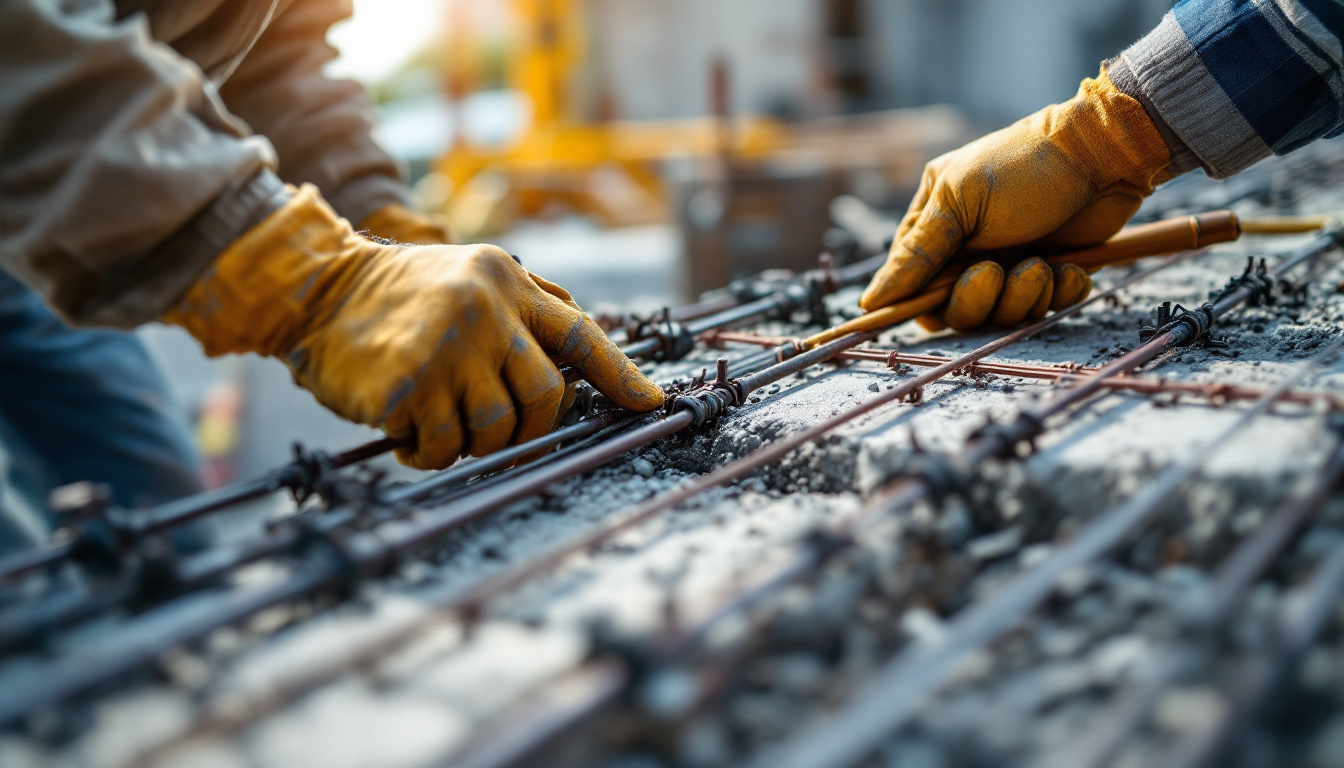The use of reinforced concrete has become a cornerstone of modern construction, providing a robust solution for building complex structures. At the heart of this innovation lies the reobar, a critical component that enhances the performance and longevity of concrete designs. This article delves into the multifaceted role of reobars, shedding light on their importance in reinforced concrete structures.
Understanding the role of reobars in concrete structures
Reinforced concrete combines the high compressive strength of concrete with the tensile strength of steel to create a composite material that can withstand various stresses. Understanding how reobars function within this synergy is essential for engineers and designers.
The basic principles of reinforced concrete
Reinforced concrete relies on the relationship between concrete and steel reobars. While concrete resists compression well, it tends to crack under tension. Steel reobars are embedded within the concrete, providing the necessary tensile strength. This interaction allows structures to endure a greater load and resist deformation.
The arrangement of reobars is crucial; they are typically placed in grids or patterns, strategically located to optimise load distribution. This methodology ensures that the overall design can accommodate both static and dynamic loads, making it suitable for applications ranging from bridges to high-rise buildings. Additionally, the diameter and spacing of the reobars are meticulously calculated based on the specific requirements of the structure, ensuring that the concrete can perform effectively under various conditions, including temperature fluctuations and moisture exposure.
How reobars contribute to structural integrity
Structural integrity is paramount in construction. The presence of reobars significantly enhances the durability and resilience of concrete structures. Through careful design and placement, reobars contribute to diminishing the likelihood of cracks and structural failures.
Moreover, when reinforced concrete is subjected to unusual forces—such as seismic activity or heavy winds—the reobars absorb and redistribute these stresses effectively, thereby preserving the integrity of the structure over its intended lifespan. The use of corrosion-resistant coatings on reobars is also becoming increasingly common, particularly in environments prone to moisture or saline exposure, as this further extends the life of the concrete. In addition, advancements in technology have led to the development of high-strength steel reobars, which provide even greater tensile strength, allowing for more innovative architectural designs that push the boundaries of traditional construction methods.
The science behind reobars and concrete
The relationship between reobars and concrete goes beyond mere placement; it encompasses a range of scientific principles related to material properties and interactions.
The properties of steel reobars
Steel reobars are manufactured to specific standards, with properties that are vital for their performance in concrete. Characteristics such as yield strength, tensile strength, and elongation are critical in determining how well they will function within the composite material.
Additionally, reobars are often coated or treated to resist corrosion, an important consideration in environments exposed to moisture and chemicals. This treatment extends the lifespan of reinforced concrete, making it a viable choice for various applications. The choice of coating can vary, with options such as epoxy coatings or galvanisation, each offering distinct advantages depending on the environmental conditions. For instance, in coastal areas where salt exposure is prevalent, the right protective layer can significantly mitigate the risk of corrosion, thereby enhancing the durability of the structure.
The interaction between concrete and steel
The bond between steel and concrete is an area of considerable importance. The friction and adhesion between the two materials provide the synergy required to create a unified structural element. The development of this bond takes place through a chemical interaction during the curing process of concrete.
Understanding this interaction can lead to improved design choices, such as the use of deformed reobars that enhance bonding capability. Such advancements ensure that reobars and concrete work together seamlessly under load conditions. Furthermore, the curing process itself is a critical phase in the lifecycle of concrete, as it influences the overall strength and durability of the mix. Factors such as temperature, humidity, and the water-to-cement ratio can significantly affect the hydration process, thereby impacting the final properties of the concrete. Engineers often conduct extensive testing to determine the optimal conditions for curing, ensuring that the concrete achieves its maximum potential strength and longevity.
The process of integrating reobars into concrete structures
The successful integration of reobars into concrete structures involves meticulous planning and execution. The process requires detailed knowledge of both materials and structural design principles.
Preparing the reobars for installation
Preparation of reobars is a fundamental step that involves cutting and bending to match the specifications of the design. Proper handling and storing techniques are essential to avoid any damage that could compromise their effectiveness.
Additionally, reobars may need to be coated with epoxy or other protective materials to enhance resistance to corrosion and interaction with the concrete environment. This preparation lays the groundwork for successful installation. The importance of using the correct grade of rebar cannot be overstated, as different grades offer varying levels of tensile strength and ductility, which are crucial for the structural integrity of the concrete. Furthermore, the alignment of the reobars must be checked meticulously to ensure they meet the design requirements, as even minor deviations can lead to significant structural issues down the line.
The process of pouring reinforced concrete
Pouring the concrete is a critical stage, wherein the prepared reobars are placed in their designated positions. It is vital to ensure that the reobars are not displaced during the pouring process, which could create weak points within the finished structure.
The concrete mix must be tailored to ensure a proper flow and adequate strength without compromising the reobars’ placement. After pouring, careful curing is necessary to achieve optimal bonding and strength development. The curing process, which can last several days, is essential for preventing cracking and ensuring that the concrete reaches its intended strength. During this time, it is important to monitor temperature and moisture levels, as extreme conditions can adversely affect the curing process. Additionally, the use of curing compounds can help retain moisture and promote a more uniform curing environment, ultimately leading to a more durable and resilient concrete structure.
The benefits of using reobars in concrete structures
The incorporation of reobars into concrete structures offers numerous benefits that enhance both performance and longevity.
Enhancing the strength and durability of structures
Safety strips are instrumental in augmenting the overall strength of concrete structures. Their ability to resist tensile stresses turns the composite material into a formidable option for construction.
Moreover, the durability of reinforced concrete in various environmental conditions is vastly improved, making it suitable for a wide range of applications, from residential buildings to industrial facilities and infrastructure projects.
In addition to their strength-enhancing properties, reobars also contribute to the ductility of concrete. This means that structures can withstand unexpected loads and deformations without catastrophic failure, which is particularly crucial in areas prone to seismic activity. The flexibility provided by reobars allows for a more forgiving design, accommodating minor shifts and movements without compromising structural integrity.
Mitigating the effects of environmental factors
Environmental factors such as moisture, chemicals, and temperature fluctuations can significantly impact the lifespan of a concrete structure. By employing reobars with appropriate protective coatings, these adverse effects can be mitigated to a substantial extent.
This resilience allows for a reduction in maintenance costs and prolongs the service life of structures, providing a sustainable construction solution. Furthermore, the choice of materials for reobars can also enhance their resistance to corrosion, which is particularly important in coastal regions where salt exposure is prevalent. Innovative solutions such as stainless steel or epoxy-coated reobars are increasingly being adopted to further extend the durability of concrete in harsh environments, ensuring that structures remain safe and functional for decades.
The future of reobars in concrete construction
As the construction industry evolves, so too do the materials and methods employed to create robust structures. The future of reobars is promising, characterised by innovation and sustainability.
Innovations in reobar technology
Advancements in rebar technology, including the development of high-strength, lightweight materials, are paving the way for more efficient construction methods. Smart reobars embedded with sensors for monitoring stress and strain are also emerging, offering real-time data for structural health monitoring.
These innovations hold the potential to revolutionise construction practices, ensuring enhanced safety, efficiency, and longevity of structures.
Sustainable practices in reinforced concrete construction
The push towards sustainability is reshaping the construction industry, and reobars are no exception. The future may see a greater emphasis on recycling materials and using sustainable practices throughout the production and installation processes.
Utilising eco-friendly manufacturing methods and alternative materials can greatly contribute to reducing the structural carbon footprint, aligning with global sustainability goals.
In conclusion, reobars play a vital role in reinforced concrete structures, contributing significantly to their strength, durability, and overall performance. As innovations continue to emerge, the future of rebar technology looks promising, paving the way for more resilient and sustainable construction practices.


